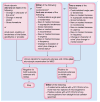Urinary tract infection in older adults
- PMID: 24391677
- PMCID: PMC3878051
- DOI: 10.2217/ahe.13.38
Urinary tract infection in older adults
Abstract
Urinary tract infection and asymptomatic bacteriuria are common in older adults. Unlike in younger adults, distinguishing symptomatic urinary tract infection from asymptomatic bacteriuria is problematic, as older adults, particularly those living in long-term care facilities, are less likely to present with localized genitourinary symptoms. Consensus guidelines have been published to assist clinicians with diagnosis and treatment of urinary tract infection; however, a single evidence-based approach to diagnosis of urinary tract infection does not exist. In the absence of a gold standard definition of urinary tract infection that clinicians agree upon, overtreatment with antibiotics for suspected urinary tract infection remains a significant problem, and leads to a variety of negative consequences including the development of multidrug-resistant organisms. Future studies improving the diagnostic accuracy of urinary tract infections are needed. This review will cover the prevalence, diagnosis and diagnostic challenges, management, and prevention of urinary tract infection and asymptomatic bacteriuria in older adults.
Keywords: aging; asymptomatic bacteriuria; elderly; urinary tract infection.
Figures

References
-
- Sobel JD, Kaye D. Urinary tract infections. In: Mandell Gl, Bennett JC, Dolin R., editors. Mandell, Douglas, and Bennett’s: Principles and Practice of Infectious Disease. 7. Elsevier; PA, USA: 2010. pp. 957–985.
-
- Nicolle LE, Bradley S, Colgan R, et al. Infectious Diseases Society of America guidelines for the diagnosis and treatment of asymptomatic bacteriuria in adults. Clin Infect Dis. 2005;40(5):643–654. - PubMed
-
- Nicolle LE SHEA Long-Term-Care-Committee. Urinary tract infections in long-term-care facilities. Infect Control Hosp Epidemiol. 2001;22(3):167–175. - PubMed
-
- Tsan L, Langberg R, Davis C, et al. Nursing home-associated infections in Department of Veterans Affairs community living centers. Am J Infect Control. 2010;38(6):461–466. - PubMed
-
- Cotter M, Donlon S, Roche F, Byrne H, Fitzpatrick F. Healthcare-associated infection in Irish long-term care facilities: results from the First National Prevalence Study. J Hosp Infect. 2012;80(3):212–216. - PubMed
Grants and funding
LinkOut - more resources
Full Text Sources
Other Literature Sources
